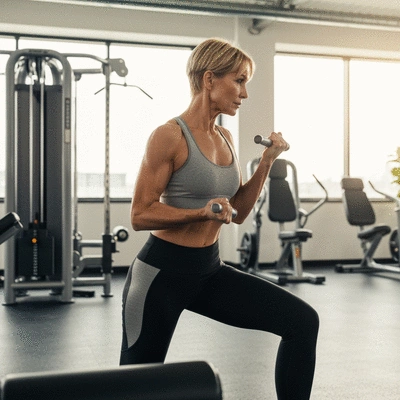Movement Science in Exercise Physiology
By Dr. Lena Schippert / Nov 10
Have you ever felt sore in unexpected places after a workout? This often points to poor form during your exercises. Understanding and applying proper movement techniques is essential not just for enhancing performance, but also for preventing injuries. Let’s dive into the critical aspects of exercise form that can transform your fitness journey!
Understanding and applying proper form, professional guidance, and smart training load management are critical for a safe and effective fitness journey. For a deeper understanding of how the body moves, explore the key principles of biomechanics in functional fitness.
Ensures efficient movement, maximizes results, and minimizes stress on joints, directly reducing the risk of strains and sprains.
Provides tailored feedback and corrective strategies, crucial for overcoming poor habits and achieving long-term safety and progress.
Balances intensity and volume to prevent overtraining, burnout, and fatigue, forming a strong foundation for performance gains.
Supports muscle repair and overall bodily functions, preventing injuries from overuse and optimizing performance outcomes.
When it comes to achieving optimal movement, understanding the importance of proper form is crucial. It’s not just about lifting weights or completing a workout; it’s about how you move your body to prevent injuries and promote long-term functionality. Have you ever finished a workout feeling sore in unexpected places? Often, that’s a sign of poor form creeping into our routines. By focusing on our technique, we can enhance our performance while safeguarding our health!
At Functional Fitness & Movement Science, I emphasize that proper form is a foundational aspect of any exercise regimen. Ignoring it can lead to unnecessary strain and injuries. So, let’s explore why correct form matters for injury prevention.
Proper form is vital for injury prevention because it ensures that your body mechanics function as they should. When you maintain correct alignment and movement patterns, you reduce the risk of stress on your joints and muscles. Here’s why focusing on form is essential:
As I often tell my clients, achieving optimal movement starts with understanding how your body functions. Maintaining awareness of your form can boost your confidence in the gym and lead to greater satisfaction with your fitness journey.
Let’s take a moment to consider how poor exercise form contributes to common injuries. Many individuals experience issues like back pain, knee injuries, or shoulder strains, often due to misguided movement patterns. Here are some primary ways that improper form can lead to injuries:
Recognizing these patterns is the first step towards correcting them. I encourage everyone to reflect on their form during exercise, as it can significantly impact their overall health.
Biomechanics plays a significant role in understanding how we move. Essentially, it’s the science of how our bodies function in motion. By applying biomechanical principles, we can achieve the correct form necessary for safe exercise practices. Here are some key aspects:
At Functional Fitness & Movement Science, I emphasize the significance of biomechanics in exercise routines. By grasping these concepts, we can improve our exercise form and, consequently, our overall fitness journey.
To enhance your awareness of proper form, consider recording your workouts. Watching yourself in action can help identify poor movement patterns that you may not feel while exercising. This self-assessment tool is invaluable for making necessary adjustments and improving your overall performance!
As we wrap up our discussion on the significance of proper form in exercise, let’s take a moment to reflect on the vital insights we've gathered. The relationship between exercise technique and injury prevention is clear. Practicing the correct form reduces your risk of injury and enhances the effectiveness of your workouts. Proper technique not only maximizes the benefits of your exercise routine but also promotes longevity in your fitness journey!
Here are some of the major benefits of maintaining proper exercise technique:
By prioritizing these aspects, you're setting yourself up for a sustainable fitness routine that focuses on health rather than just appearance. Remember, every small adjustment you make contributes significantly to your body's overall health!
Seeking professional guidance can be a game-changer for your fitness journey. It’s easy to fall into the trap of self-correcting without realizing we're reinforcing poor habits. That's why I often encourage individuals to consider working with a qualified trainer or exercise physiologist. They can provide personalized feedback and corrective strategies tailored to your unique needs.
Here’s why professional guidance can be invaluable:
With the right support, you’ll feel empowered to push your limits safely and effectively. So, if you haven’t already, consider reaching out to a professional in the field! You can also find valuable information on injury prevention exercises for training to complement your professional guidance.
Another key factor in preventing injuries is understanding and managing your training load. This concept involves balancing the intensity and volume of your workouts to avoid overtraining. Just as I advise my clients at Functional Fitness & Movement Science, taking a strategic approach to training load can dramatically influence your progress and safety.
Consider these strategies for effective training load management:
By focusing on load management, you set a strong foundation for both **performance gains** and injury prevention. Trust me; your body will thank you for it in the long run!
Now that we've covered the essentials of proper form and injury prevention, it’s time to take action! Implementing these tips into your routine can transform how you approach exercise. Remember, every step you take toward improving your form brings you closer to a healthier lifestyle.
Start incorporating the insights we've discussed today into your workouts. Here’s a simple guide to help you get started:
Each of these steps builds towards a safer and more effective exercise routine. Trust me; with perseverance and dedication, you'll feel the difference!
Continuous learning is essential for enhancing your understanding of exercise form. I recommend exploring various resources to deepen your knowledge:
Investing time in these resources will empower you with the knowledge needed to maintain optimal form and prevent injuries in the long run. For additional insights, consider reading about injury prevention strategies for lifelong activity.
Lastly, let’s not overlook the role of nutrition in your journey toward safer workouts. Proper nutrition is critical for recovery and can significantly affect your performance. As I emphasize often, fueling your body with the right nutrients helps it recover and repair, preventing injuries from overuse or fatigue.
Here are some nutrition tips to support your recovery:
By combining these nutritional strategies with proper form and training load management, you're setting yourself up for long-term health and success. Let’s keep moving forward together—safely and effectively!
Here is a quick recap of the important points discussed in the article:



 Movement Science in Exercise Physiology
In the world of fitness, understanding the intricate relationship between how we move and the scienc
Movement Science in Exercise Physiology
In the world of fitness, understanding the intricate relationship between how we move and the scienc
 Fixing Poor Form for Safety
Have you ever felt sore in unexpected places after a workout? This often points to poor form during
Fixing Poor Form for Safety
Have you ever felt sore in unexpected places after a workout? This often points to poor form during
 Injury Prevention Strategies for Lifelong Activity
What if the secret to a longer, healthier life lies in understanding how we move? By focusing on inj
Injury Prevention Strategies for Lifelong Activity
What if the secret to a longer, healthier life lies in understanding how we move? By focusing on inj